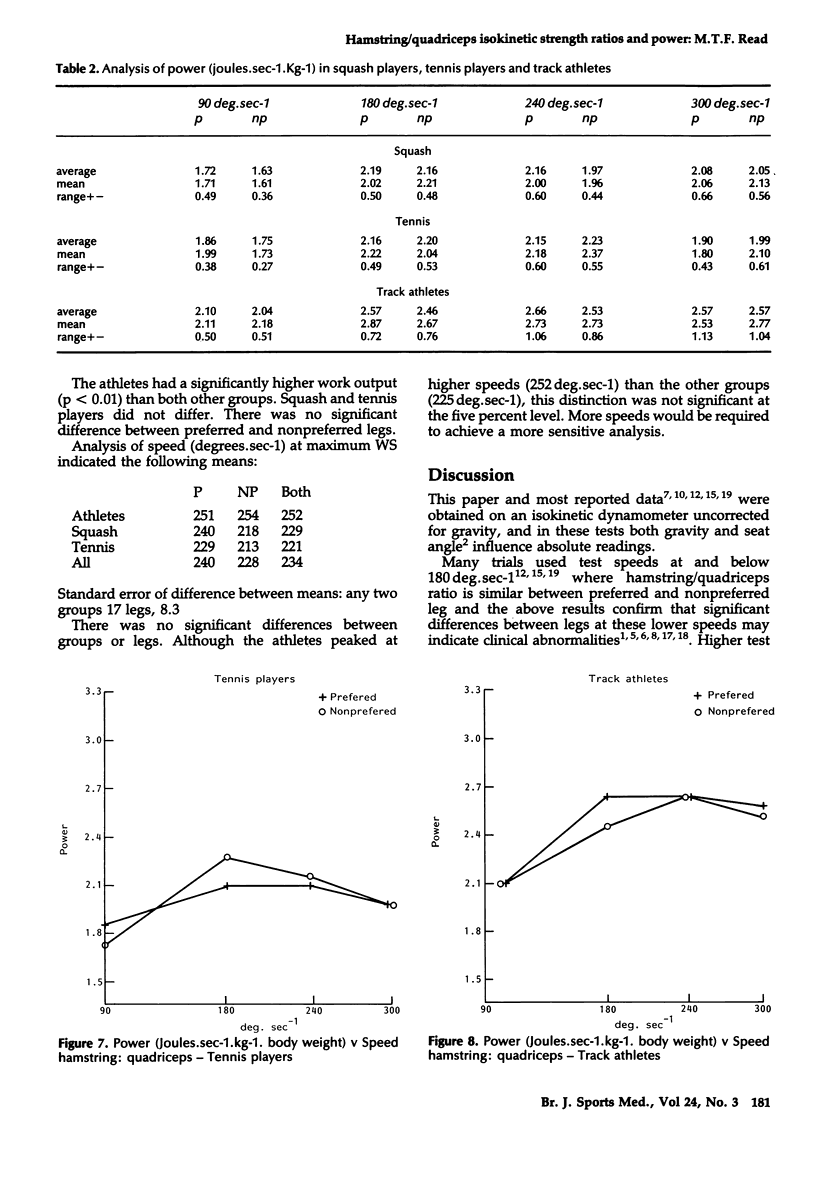Abstract
Isokinetic assessment of elite squash, tennis and track athletes confirms the accepted ratio of 60 to 80 per cent hamstring to quadriceps when testing at 90 deg-sec-1 for peak strength (torque). However, significant variations occur at higher test speeds up to 300 deg.sec-1 with the hamstrings becoming more prominent especially (p less than 0.001) in the nonpreferred (NP) leg. There was no significant difference between sports, and wide individual differences occurred. Analysis of (work.sec-1.kg-1 body weight) power showed a significantly higher work output (p less than 0.01) by track athletes than squash and tennis players, but, unlike hamstring/quadriceps ratio, no significant difference between preferred (P) and nonpreferred leg. The maximum power output was achieved around 220 to 250 deg.sec-1. Power between preferred and nonpreferred legs was the same but the torque ratio differed indicating that the hamstrings provided proportionately more work in the NP leg at higher speeds.
Full text
PDF




Selected References
These references are in PubMed. This may not be the complete list of references from this article.
- Charteris J., Goslin B. R. The effects of position and movement velocity on isokinetic force output at the knee. J Sports Med Phys Fitness. 1982 Jun;22(2):154–160. [PubMed] [Google Scholar]
- Imwold C. H., Rider R. A., Haymes E. M., Green K. D. Isokinetic torque differences between college female varsity basketball and track athletes. J Sports Med Phys Fitness. 1983 Mar;23(1):67–73. [PubMed] [Google Scholar]
- Lesmes G. R., Costill D. L., Coyle E. F., Fink W. J. Muscle strength and power changes during maximal isokinetic training. Med Sci Sports. 1978 Winter;10(4):266–269. [PubMed] [Google Scholar]
- Mendler H. M. Knee extensor and flexor force following injury. Phys Ther. 1967 Jan;47(1):35–45. doi: 10.1093/ptj/47.1.35. [DOI] [PubMed] [Google Scholar]
- Murray M. P., Gardner G. M., Mollinger L. A., Sepic S. B. Strength of isometric and isokinetic contractions: knee muscles of men aged 20 to 86. Phys Ther. 1980 Apr;60(4):412–419. doi: 10.1093/ptj/60.4.412. [DOI] [PubMed] [Google Scholar]
- Watkins M. P., Harris B. A. Evaluation of isokinetic muscle performance. Clin Sports Med. 1983 Mar;2(1):37–53. [PubMed] [Google Scholar]


